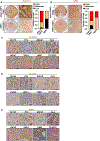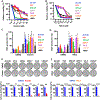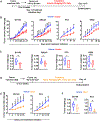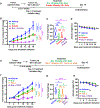Ferroptosis Inducers Are a Novel Therapeutic Approach for Advanced Prostate Cancer
- PMID: 33483372
- PMCID: PMC7969452
- DOI: 10.1158/0008-5472.CAN-20-3477
Ferroptosis Inducers Are a Novel Therapeutic Approach for Advanced Prostate Cancer
Abstract
Ferroptosis is a type of programmed cell death induced by the accumulation of lipid peroxidation and lipid reactive oxygen species in cells. It has been recently demonstrated that cancer cells are vulnerable to ferroptosis inducers (FIN). However, the therapeutic potential of FINs in prostate cancer in preclinical settings has not been explored. In this study, we demonstrate that mediators of ferroptosis, solute carrier family 7 member 11, SLC3A2, and glutathione peroxidase, are expressed in treatment-resistant prostate cancer. We further demonstrate that treatment-resistant prostate cancer cells are sensitive to two FINs, erastin and RSL3. Treatment with erastin and RSL3 led to a significant decrease in prostate cancer cell growth and migration in vitro and significantly delayed the tumor growth of treatment-resistant prostate cancer in vivo, with no measurable side effects. Combination of erastin or RSL3 with standard-of-care second-generation antiandrogens for advanced prostate cancer halted prostate cancer cell growth and migration in vitro and tumor growth in vivo. These results demonstrate the potential of erastin or RSL3 independently and in combination with standard-of-care second-generation antiandrogens as novel therapeutic strategies for advanced prostate cancer. SIGNIFICANCE: These findings reveal that induction of ferroptosis is a new therapeutic strategy for advanced prostate cancer as a monotherapy and in combination with second-generation antiandrogens.
©2021 American Association for Cancer Research.
Conflict of interest statement
Conflicts of interest:
The authors declare no competing interests.
Figures






References
-
- Siegel RL, Miller KD, Jemal A, Cancer statistics, 2020. CA: A Cancer Journal for Clinicians 2020; 70: 7–30. - PubMed
-
- Denis LJ, Griffiths K, Endocrine treatment in prostate cancer. Seminars in Surgical Oncology 2000; 18: 52–74. - PubMed
-
- Sharifi N, Dahut WL, Steinberg SM, Figg WD, Tarassoff C, Arlen P et al., A retrospective study of the time to clinical endpoints for advanced prostate cancer. BJU International 2005; 96: 985–989. - PubMed
-
- Fizazi K, Shore N, Tammela TL, Ulys A, Vjaters E, Polyakov S et al., Darolutamide in Nonmetastatic, Castration-Resistant Prostate Cancer. New England Journal of Medicine 2019; 380: 1235–1246. - PubMed
-
- Scher HI, Fizazi K, Saad F, Taplin ME, Sternberg CN, Miller K et al., Increased survival with enzalutamide in prostate cancer after chemotherapy. N Engl J Med 2012; 367: 1187–1197. - PubMed
Publication types
MeSH terms
Substances
Grants and funding
LinkOut - more resources
Full Text Sources
Other Literature Sources

